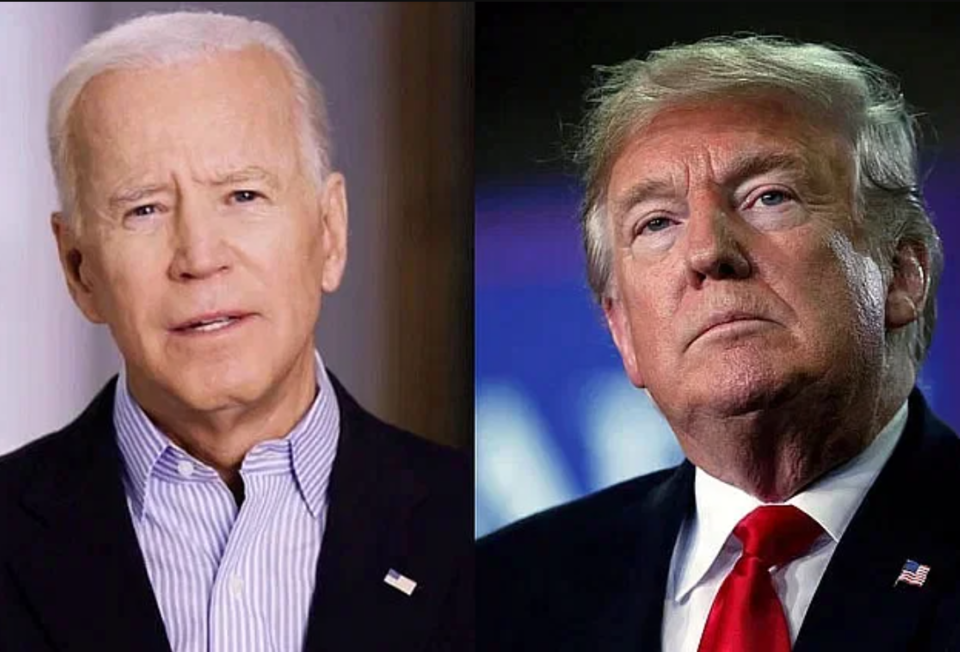This has been a recurring theme of the US presidential campaign—did the US economy do better under Joe Biden or Donald Trump? Democratic Party Vice President Kamala Harris said, ‘Our economy is the strongest in the world by many indicators.
Republican candidate and former President Trump said he had built “the greatest economy in the history of our country” and that the Biden-Harris administration had destroyed it. We look at some key indicators to compare economic performance under the two presidencies.
US economic growth
Although the impact of Covid has made comparisons difficult, both presidents can count some notable economic successes despite struggling to keep up with wage growth in recent years. First, let’s look at economic growth using gross domestic product (GDP), the value of all goods and services in the U.S. economy.
This number dropped dramatically during Covid as many businesses closed. After the pandemic, the economy rebounded strongly under Trump and recovered better than many other Western countries. As it continues under Mr. Biden, the United States has the strongest pandemic recovery among the G7 as measured by GDP.
But during Trump’s four years in office, it was not the greatest economy in US history, as he likes to claim. Between January 2017 and January 2021, the average annual growth rate was 2.3%. This period includes the recession and recovery of the economy as a result of the Covid pandemic.
That number is 2.2%—so about the same—under the Biden administration so far. There have been periods in the past when GDP growth under both Trump and Biden was significantly higher than average, such as in the 1970s.
Inflation.
The rate at which prices are rising has been a major campaign issue. Prices rose significantly in the first two years under Biden—peaking at 9.1% in June 2022. Trump said the United States was experiencing “the worst inflation we’ve ever had.” But that’s not true—inflation was over 9% in 1981, far higher than at any other point in US history. Inflation is now down to about 3%—but it remains higher than when Trump left office.
For example, grocery prices increased by 13.5% over the year ending August 2022. It peaked under the Biden administration and prices have stabilized somewhat, with grocery prices rising 1.1% from July 2023 to July this year. The recent trend is comparable to many other Western countries that experienced higher inflation rates in 2021 and 2022, as global supply chain problems driven by Covid and the war in Ukraine contributed to price increases.
But some economists say Mr Biden’s $1.9 tn (£1.5 tn) American rescue plan, which was passed in 2021, was also a factor – as the injection of cash into the economy pushed prices higher. Employment The Biden administration has repeatedly pointed to strong employment growth as a major achievement. Before the big job losses in 2020 due to Covid, about 6.7 million jobs were added in the first three years of Trump’s presidency, according to non-farm payrolls data (which includes about 80% of workers in the labor force) and about 1 million since the Biden administration took office in January 2021. 60 million employment has increased. Mr Biden claimed it was “the fastest job growth of any president in American history”.
That’s right—if you look at the data available since records began in 1939. But his administration has benefited from a sharp return to economic activity as the country emerges from a pandemic lockdown. “Many jobs would have returned if Trump had won in 2020—but the American rescue plan played a major role in the speed and aggressiveness of the labor market recovery,” said Mark Strain, an economist at Georgetown University.
The spending plan, adopted under the Biden administration in 2021, was designed to help stimulate the economy after the pandemic. Weaker-than-expected jobs growth in July sparked fears of a sudden recession in the US economy and hurt stock markets, but they have since stabilized. Both administrations have pointed to lower unemployment levels under their leadership. Before the pandemic, Trump gave a 3.5 percent unemployment rate. As in many parts of the world, the Covid lockdown measures raised the unemployment rate in the US – but after Trump left office the unemployment rate fell to around 7%. Under the Biden administration, the unemployment rate fell to a low of 3.4 percent in January 2023—the lowest rate in more than 50 years—but has since peaked at 4.3 percent.
As for wages, they rose under Trump but at the same rate as his predecessor Barack Obama before the pandemic hit.
Workers’ wages rose sharply in early 2020 during the Covid pandemic—but the sudden rise in wages was linked to the likelihood of layoffs for low-wage workers, which pushed up the average wages of those still employed. Under Mr Biden, average weekly earnings have risen, but they have struggled to keep up with rising prices due to high levels of inflation.
Adjusted for inflation, median weekly wages were lower when Biden took office.
financial markets
The US stock market is not necessarily a reflection of the broader economy, but many Americans have investments, so its performance carries some weight. The Dow Jones Index is a measure of the performance of the 30 largest companies listed on the US stock exchange. It reached record highs during Trump’s presidency, but collapsed as markets reacted to the pandemic, erasing all gains made under Trump.
However, by the time Trump left office in January 2021, financial markets had returned above pre-pandemic levels. They have continued to rise under Mr. Biden, and although there have been recent upheavals, they have also reached record levels under his administration.

